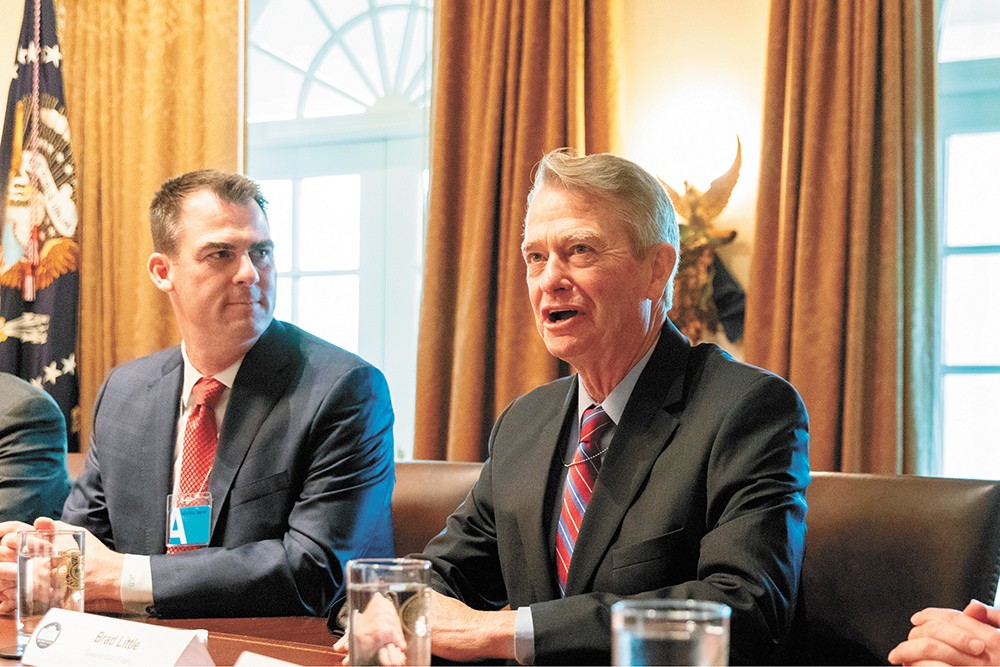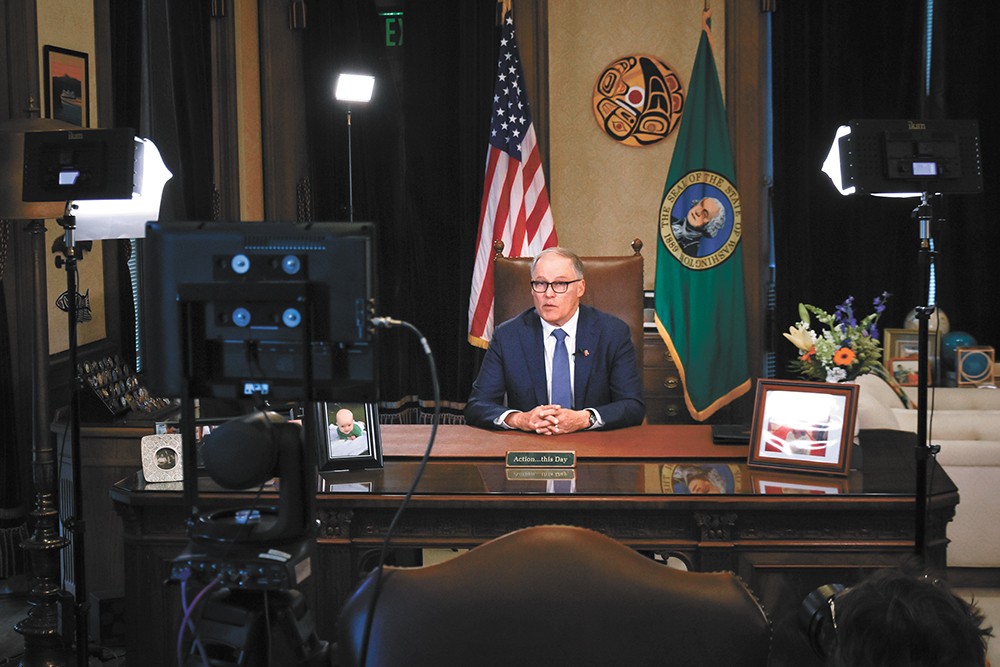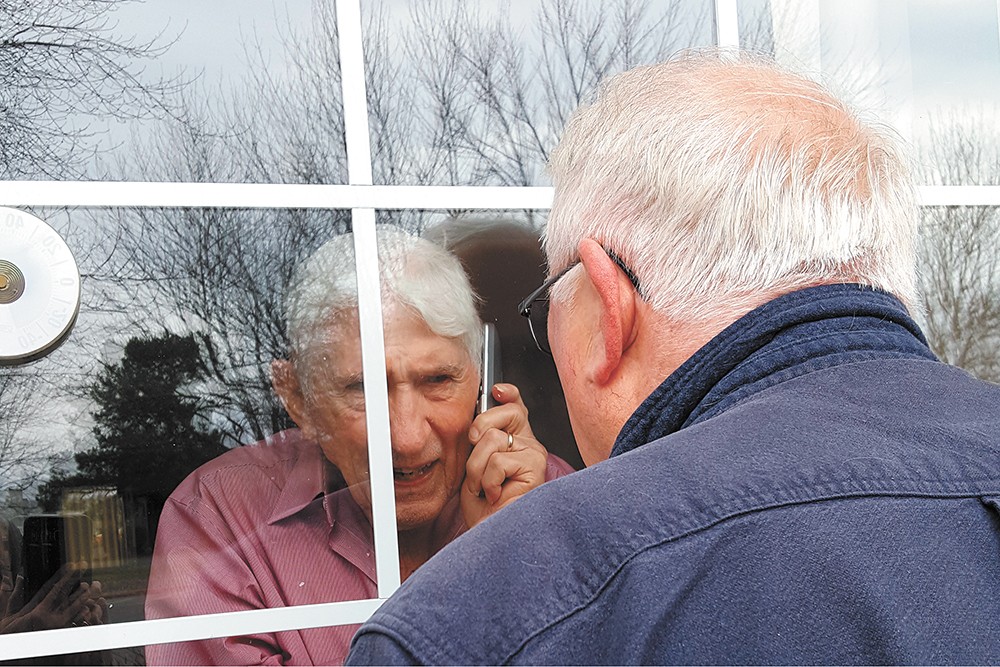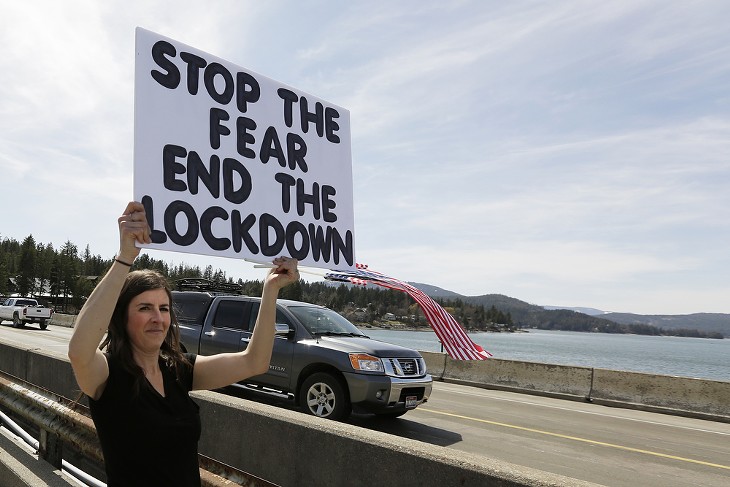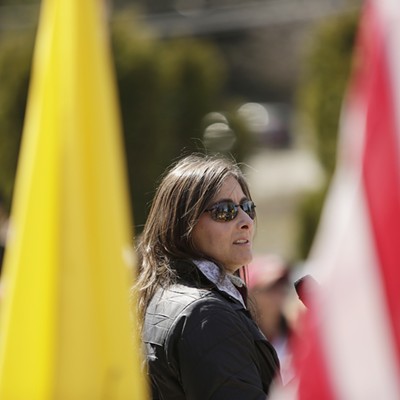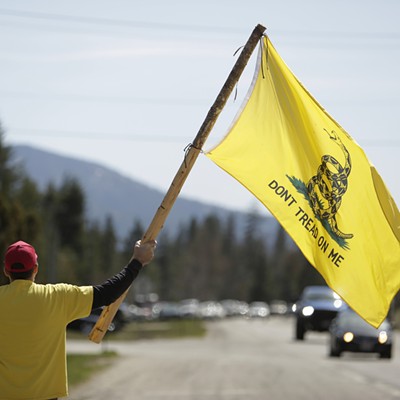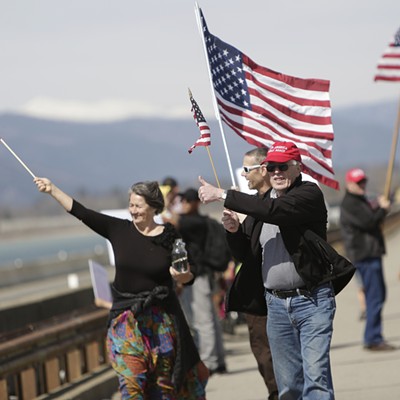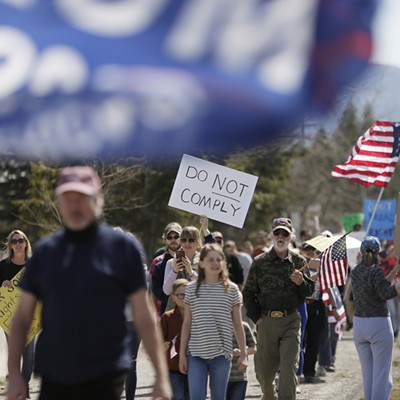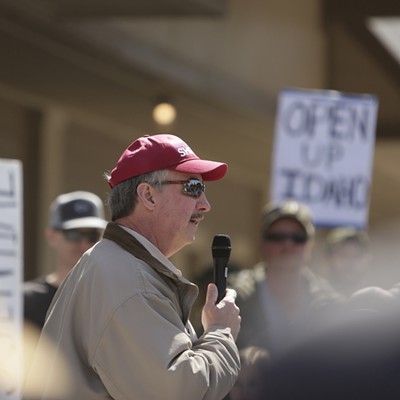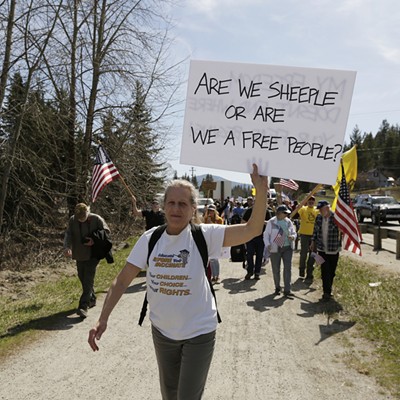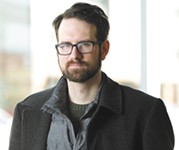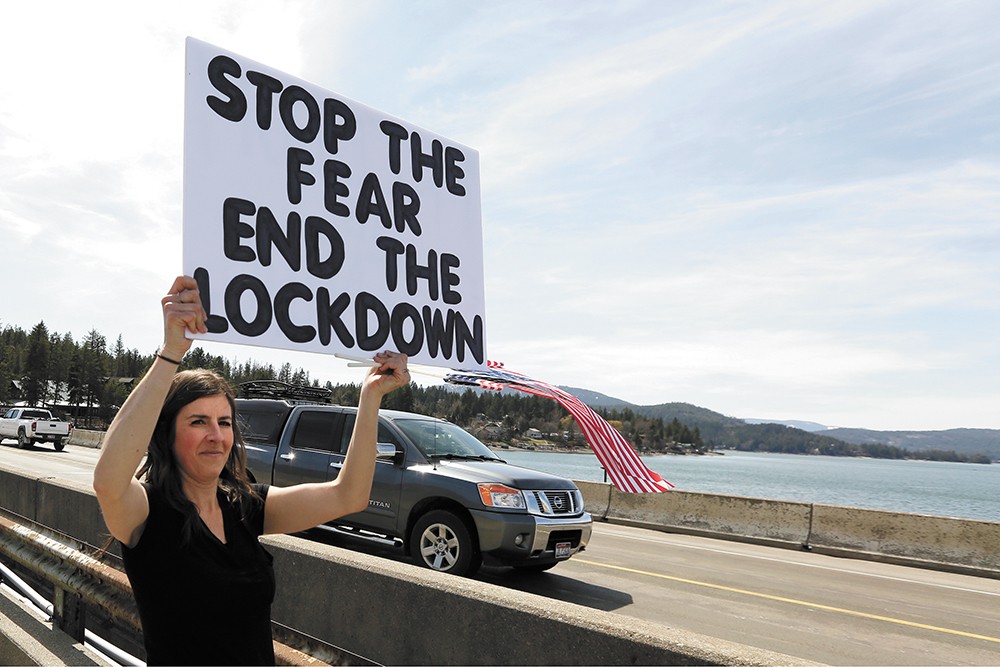
When Washington Gov. Jay Inslee solemnly looked into the camera on Friday, May 1, he wasn't ready to declare victory yet.
"We have not won this fight against this virus," Inslee said.
Washington has been under a stay-home order for more than five weeks. But even though the coronavirus infection rate was slowing in the state, Inslee said it would be at least another month before Washington could return to any semblance of normalcy.
"We don't want to do this twice," he said.
By contrast, on the same day Inslee delivered his address, some businesses in Idaho were already going back to work and, on Sunday, churches resumed services.
In his own address the day before Inslee's, Idaho Gov. Brad Little said "90 percent of businesses" would soon open their doors in the state even as most in Washington remain closed. And while Inslee, a Democrat, has publicly sparred with President Donald Trump over the federal response to the pandemic, Little proudly touted Idaho's approach as being in line with Trump's.
"Every step of the way, we have followed the president's guidance to slow the spread of the coronavirus and responsibly open businesses back up," Little said.
As they unveil their plans to reopen their states, each governor has had to fend off a rising death toll with one hand, and a collapsing economy with the other.
Led by Inslee, Washington has been heralded as a national model in slowing the spread of the coronavirus, taking early steps to shutter schools, restaurants and large gatherings. But where Washington is one of the most liberal states in the country, Idaho is one of the most conservative.
Little, himself a Republican, has been thrust in the crossfire between health officials, libertarian activist groups and members of his own party. Still, he's aware of the stakes: Back in March, he published a statement declaring that "history will remember how we dealt with coronavirus."
"Let's keep everything in perspective and take a deep breath," Little wrote. "Keep doing your part — listen to our public health experts about what to do and, most of all, 'love thy neighbor.'"
But there's the problem: Viruses don't respect state borders. And so despite having mismatched politics, Washington and Idaho's fates are intertwined.
As Dr. Bob Lutz, Spokane Regional Health Officer, says: "It's not like you have this wall that exists at the state line that says, 'COVID-19 isn't east of this wall, it's west of this wall, stay over there.'"
LITTLE CHOICE
By March 17, everyone knew the world was beginning to fall apart. In Washington state, 54 people had already died from COVID-19 and more than 1,000 were infected. Inslee had taken unprecedented steps to shutter schools and sit-down restaurants and ban gatherings of more than 50 people. By then, even President Trump, who had been skeptical of the coronavirus, had called for gatherings to be limited to 10 people.
Yet, the Idaho Legislature was still in session, with lawmakers packed inside the capitol. And so when Moscow Sen. David Nelson stood to speak, he didn't simply see his colleagues as Democrats or Republicans, but as potential disease vectors — envisioning infected legislators unknowingly spreading the virus throughout the state and into rural towns where the hospitals couldn't take the strain.
To continue to meet was utterly reckless, argued Nelson, one of Idaho's rare Democratic lawmakers.
"I will not put my family, neighbors and community at risk," he told his colleagues. He was going home: "Good luck to all of you in this national crisis."
Meanwhile, Little and his team of experts were watching for evidence of "community spread" showing that the virus was spreading within Idaho. In Blaine County, in the south-central part of the state, they spotted the early signs of what would be Idaho's first major outbreak.
Should Little shut down the entire state, before other areas had their own cases? Or should he resist following the path of liberal states like Washington?
"He's always cognizant of the pressure, on both sides," says Dave Jeppesen, director of the state Department of Health and Welfare, who's been at Little's side throughout the pandemic.
Publicly, Little initially suggested that a statewide shut down was unlikely. That would be like Trump closing down the whole country when "things started in the Seattle area," he told reporters. But privately, as cases in Blaine County began to explode, he and his team of experts watched for signs that could force him to issue a statewide order, Jeppesen says.
While Little grew up on a ranch and sometimes dons a cowboy hat, he was never the type of leader to shoot from the hip. Friends and former colleagues describe the governor as a details guy, the sort who digs into research and surprises legislators by hitting them with arcane questions about their bills.
But there was a lot to consider: First, Idaho isn't Washington.
"Idaho's a lot different than those other states," Little said recently. "We don't have mass transit. We don't have a high percent of our population that lives in crowded areas."
Still, the pressure on Little was mounting on a variety of fronts. On March 16, more than 80 restaurants signed a letter to Little begging him to force them to close. "We need you to shut down our industry to save it," the restaurant owners argued, reasoning that only by defeating the virus would they be able to thrive.
On national television, MSNBC host Rachel Maddow hammered Little on multiple segments, contrasting Little's relative lack of action with the rising death toll.
"Yeah, no rush, governor," Maddow scoffed in late March about Little's refusal to order a statewide shutdown. "It will probably work out OK. Why not risk it."
Even the Idaho Statesman editorial page decried Little's behavior as a symptom of a typical Idaho mentality.
"Are we just waiting to take action only until there's an outbreak? By then, it will be too late," the editorial reads. "God forbid that we should use the heavy hand of government to stop this thing."
But for all the criticisms, Little's team maintained a close watch on the data, Jeppesen notes. They were looking out for two things in particular, he says. First, they kept an eye out for community spread in multiple locations. Second, without strong testing for the coronavirus, they were watching how many people were going into emergency rooms and testing negative for the flu.
"In the third week of March, we saw a dramatic increase across the state in people showing up at the hospital with COVID-like symptoms," Jeppesen says.
On March 25, Little announced a stay-home order, "following the guidance of public health experts."
Cue the backlash: That same day, Wayne Hoffman, president of the libertarian Idaho Freedom Foundation, fired off a letter to the governor's office claiming it was unconstitutional to "take away people's right to earn a living, to assemble, and to move about freely" and that history would remember "how people were forced to surrender their freedom for the notion of security."
Other objections came from defiant pastors. Despite personally knowing two people who contracted COVID, Coeur d'Alene pastor and state Rep. Tim Remington held an in-person service anyway and argued that the virus was targeting particularly sinful cities.
"It's kind of funny, all the ones that are coming against God, a lot of this is hitting in those cities," Remington preached on March 29. "In Seattle — big time. Waiting on D.C."
"When you've got diametrically opposed philosophical practices and approaches, it makes public health work a lot more difficult."
tweet this
But another profession heaped praise upon Little: doctors. Tommy Ahlquist, a former ER doctor, had run for governor in 2018, and he was hammered with Little's attack ads. But after that, he called Little "one of the finest men I know," praised his stay-home order and declared he would "spend the next 21 days doing all I can to support his order and leadership."
Ahlquist went one step further. He started making phone calls to board members and CEOs, hammering together a coalition, dubbed Crush the Curve Idaho, to fight the spread of the coronavirus enough to reopen business. And as he spoke with experts, one problem kept rising to the top.
"All I heard from everyone is there's not enough testing," Ahlquist says.
Without testing, tracking the virus is impossible. Already, the virus was spreading unseen through rural Idaho.
UNSEEN KILLER
On March 27, Monty Spears went to visit his father, Jack, at the Life Care Center of Lewiston. Monty was worried. Jack, 93, was vulnerable to the virus, and it snuck into the facility days earlier, infecting him and several other residents.
Monty spoke to his dad through a pane of glass. It turned out to be the last time they'd see each other.
"I told him I loved him and he told me that he loved all of his kids," Monty Spears says. "It was really painful because we couldn't go to him, and we knew he was sick."
Within days, Jack went into a coma and, on April 6, died. Other residents on the same floor were infected, including his wife. So far at least eight have died of COVID-19.
With 18 deaths and counting, Nez Perce County has the most coronavirus deaths in the state, with most of those cases connected to the Life Care Center of Lewiston. It's the exact scenario health experts fear for Idaho: The virus spreading undetected in rural communities, before a burst of deaths among a vulnerable population.
And that doesn't just impact Idaho. It impacts the other side of the border.
"When you've got diametrically opposed philosophical practices and approaches, it makes public health work a lot more difficult," says Lutz, the health officer for both Spokane and Asotin counties.
On the other side of the Snake River from the Lewiston facility, Lutz was growing concerned for Asotin County. Even though there were no confirmed cases, he suspected otherwise.
For rural areas anywhere, testing is difficult. The tests are often sent to labs far away, in Boise or Seattle, and can take days to get results. In Clarkston, test kits were sent across the river to Lewiston, but that lab operated on stricter testing criteria than Washington in order to preserve resources.
By April 7, Lutz asked the state to send 300 test kits down to Asotin County so the health department could test more people. As he expected, the virus had jumped the border.
On the Idaho side, it's a different story. While Lutz sees increasing testing as an essential duty, Carol Moehrle, district director for public health in Idaho's North Central District, tells the Inlander that COVID-19 testing is not a public health function. They don't have physicians like Lutz on staff, so instead hospital systems must conduct the tests. At one point, Nez Perce County had 11 deaths out of 22 total cases — reflecting both how the virus attacks vulnerable populations and the early lack of testing.
"Some of our counties are very rural, and one of the early challenges is that the hospitals have had very few test kits," she says. "They've had to prioritize."
That's caused some hospitals in rural areas to refuse tests to symptomatic individuals entirely, unless they're health care workers or elderly.
In late March, Lindsay Wagenmann, 34, tried desperately to get tested when her doctor told her she "100 percent" had COVID-19. But local hospitals refused to test her. Her sister, a nurse in Pullman, Washington, told her to come there, where they were doing drive-thru testing, but Wagenmann didn't have the strength for the four-hour trip.
She never got tested, and neither did anyone she potentially came in contact with as a hairdresser.
"It was absolutely frustrating," she says.
Through most of April, Washington was testing at twice the rate of its population compared to Idaho. Yet Washington's numbers are skewed because of Seattle. In Eastern Washington, just like much of Idaho, health districts have limited testing resources, Lutz says. And if you're talking about any reopening plan, robust testing of even some asymptomatic individuals is a must.
"If we had done that from the get-go, we'd be a lot further along in flattening the curve and the phases of reopening," Lutz says.
Without that, rural areas remain vulnerable. They may be able to avoid seeing the virus for a while, but if it starts to spread, struggling hospitals in rural areas typically don't have the intensive care units to handle big surges. "It's sort of a tightrope" that rural communities are walking, says Eric Lofgren, an infectious disease epidemiologist at Washington State University.
Ben Ridenhour, a University of Idaho researcher who's developed a COVID-19 model for Idaho, says the virus is less predictable with an aging population in rural areas. What makes Idaho unique, he says, is its sparse and aging population. Bigger cities will see higher case counts. But smaller communities can be just as devastated.
"Essentially, there's more variability to how the disease will play out in small populations," Ridenhour says.
The result? Hotspots. Sometimes it's easy to control. Yet sometimes it upends smaller tourist communities like Blaine County, which had one of the highest per capita infection rates in the country. It wipes out nursing homes like the Life Care Center of Lewiston. It forces a son to see his dad for the final time through the window.
THE RESISTANCE
In Sandpoint, Idaho state Rep. Heather Scott stands near the city's iconic Long Bridge. For six years, Scott tells the crowd, she's worked with Health Freedom Idaho, the anti-vaccine group that helped organize the rally, filled with "Trump Train" flags and signs with slogans like "Give Me the Virus, Don't Take My Country."
"I think a lot of us up here are always worried that they're coming for our guns. But they don't need to when we're locked in our houses."
tweet this
Scott, who drew international attention last month for calling Gov. Little "Little Hitler," is right at home.
"I think a lot of us up here are always worried that they're coming for our guns," Scott says. "But they don't need to when we're locked in our houses."
In April, a segment of Idaho's right-leaning activists turn lockdown defiance into a brand. The Freedom Foundation takes a coiled snake — a symbol of the Revolutionary War, the Tea Party, of not being tread upon — and transforms it into a "Disobey Idaho" logo. Over 1,000 show up at a Disobey Idaho rally in Boise, waving signs like "How many lives have we lost for this freedom?"
At a park in Meridian, located outside of Boise, a police officer arrests an anti-vaccine activist with Health Freedom Idaho after she repeatedly refuses to leave a closed-off playground. Her allies yell "This is the flu!" and "who's your führer?!" at the police as she's led away.
The video goes viral. And soon, Ammon Bundy — leader of the 2016 armed occupation the Malheur National Wildlife Refuge — and members of Health Freedom Idaho are in front of the suburban home of the arresting police officer, intending to present him with a "redress of grievances."
Similar acts of rebellion have unfolded across the country, including in Washington state. When Inslee banned events of more than 250 people in March, Tim Eyman, a longtime anti-tax crusader now running for governor, invited 251 people to a party, saying, "Let's stick our finger in the eye of Jay Inslee."
Nationally, however, these protesters only represent a slim portion of the country. A recent Kaiser Family Foundation poll found that 80 percent of Americans supported stay-home orders.
So while "Liberate Moscow" rally leaders believe plenty of business owners don't believe the coronavirus is a threat and are too scared to say so, Moscow City Councilwoman Brandy Sullivan says she's been flooded with hundreds of emails suggesting otherwise. About 80 percent have been offering praise for Little and urging Idaho to stay the course, she says, while an additional 5 percent actually want more restrictions.
"We have sacrificed a lot," Sullivan says. "We don't want it to be for nothing."
Ultimately, the important distinction between Idaho and Washington may be less about members of the public than those in power: Washington state's GOP leadership showed reluctance to attack Inslee for his stay-home order early on. But in Idaho, Little keeps taking friendly fire.
"The cure cannot be worse than the disease!" Idaho Republican Party Chairman Raul Labrador wrote last month, warning that continuing the shutdown would "impose real costs on Idaho families that will be felt for years to come."
On April 12, Idaho Speaker of the House Scott Bedke sent Little a letter empathizing with the governor's position, but also issuing a warning: "The way you exercise legislative powers now will affect how the Legislature views those powers when it next convenes."
Bedke called for Little to seek an "acceptable level of risk" in order to "avoid a major, long-lasting economic catastrophe" and to hand control of coronavirus policies to public health districts instead of an ill-advised "one-size-fits-all solution."
The harshest hits came from inside the executive branch.
"I AM ESSENTIAL!" declared the Facebook profile of Lt. Gov. Janice McGeachin. "Don't Tread on Me."
McGeachin vowed to do whatever she could to ensure that the shutdown didn't continue beyond April 30. In a three-page letter to Little, she warned of a potential "constitutional showdown between some of the people of Idaho and your administration."
Indeed, when Hardware Brewing Co., a small business northeast of Lewiston, opened its doors again on May 1 — in defiance of Little's stay-home order — McGeachin and Labrador attended the reopening and proudly posed beside the owner. No masks. No six feet of separation. No united front with the governor.
But in Washington state? Inslee got elected members of Republican leadership on board early. He personally called the House minority leader, J.T. Wilcox, before issuing the stay-home order.
"I told him that I thought he was doing the right thing. He was bold in his first response," Wilcox says. "We needed to take action immediately."
As time has gone on, Wilcox has expressed more frustration with provisions of Inslee's order, critiquing the governor for a lack of transparency, specificity and consistency.
But Eyman says that the Republican leaders' early support for the order left them trapped.
"They were kind of locked down," Eyman says. "They kind of felt like, 'Well, we were there at the beginning. Maybe we've got to be there at the end.'"
With Inslee's recent decision to extend his stay-home order through the entire month of May, however, Eyman believes the dam is cracking, and Inslee is going to get deluged with an angry flood from citizens and politicians alike.
"You're just like, gasping, thinking, 'OK, I'm finally at the finish line, I'm 2 yards away, I finally can get past your crap.' And he says, 'It's just another 30 days,'" Eyman says. "People are losing their minds, man."
IDAHO TIME
On April 27 — long after the first coronavirus case was detected, after the first death, after businesses were shut down and stay-home orders issued — Little and Inslee finally talked on the phone.
The topic? Washingtonians crossing the border to hunt, fish and play golf.
"A lot of folks were going into Idaho and [Little] wasn't crazy about that," says Tara Lee, a spokeswoman for Gov. Inslee's office.
It's the first time the two spoke about the pandemic, she says, and it suggests that as the two states try to safely reopen and avoid a dreaded second wave of COVID-19 deaths, they'll continue to do so separately.
The consequences of that remain to be seen.
On April 13 — ignoring President Trump's assertion that he had total authority on when states reopen — Washington, Oregon and California announced that they were joining together in a shared vision to reopen the states called the Western States Pact. Colorado and Nevada soon followed. Collaboration can "ensure the virus can never spread wildly in our communities," they said in a joint statement.
Jeppesen says Idaho has had plenty of discussions about sticking to the same timeline as bordering states. But he declined to say if Washington asked, or Idaho offered, to join the Western States Pact. Lee, with Inslee's office, says it "didn't come up" in the conversation between the two governors about Washingtonians going to Idaho to hunt and fish.
Idaho is playing by its own rules: Already, Little has allowed some businesses, churches, day cares and camps to open, and by May 16, his "Idaho Rebounds" plan calls to open restaurant dining rooms and gyms — as long as social distancing rules are followed. Bars, nightclubs and movie theaters won't open until June 16 at the earliest. While it's more aggressive than Inslee's plan, it's a lot more cautious than Republican governors in states like Georgia.
Ridenhour, the University of Idaho researcher, was pleasantly surprised with Little's gradual approach.
"I thought they might try to be pretty lenient about all of this to start off with, then see what the effect was," Ridenhour says.
Crucially, Little's plan requires the state to show low or decreasing numbers of coronavirus cases to move to each new stage. That's why fixing the testing deficit has become critical.
Ahlquist, the former ER doctor, says that the state's Crush the Curve effort has now pulled together the supply lines to run up to 4,000 tests a day — testing for not just the coronavirus but for antibodies to the disease, learning just how many people have contracted the virus but already conquered it. He says it's enough to justify gradually reopening Idaho — and just in time.
"The economy is crumbling," he says. "People are losing their livelihoods."
"I think those early decisions that were made probably helped slow the spread significantly."
tweet this
There's a caveat: The tests show that most Idaho residents don't have antibodies, meaning the state is still vulnerable. And if the cautionary tale of the 1918 pandemic is anything to go by, a second wave could be even deadlier — and a second shutdown could be a lot harder for people to accept.
And Little knows that. At a recent press conference, he laid out some of his fears: He's concerned that some people won't do the right thing. He's nervous about big events held without social distancing, held in rural communities without hospital capacity or enough testing to handle it. He's worried about more outbreaks, more surges in places like Blaine County and Nez Perce.
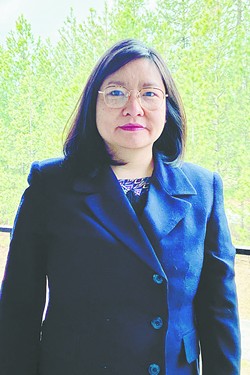
"That's what keeps me up at night," Little says.
Critics of Little's stay-home order like to point to the state's comparatively low numbers of death as proof that his restrictions weren't necessary. But Inslee's swift actions, suggests Karen Yao, a virologist in Coeur d'Alene, might have helped save lives in Idaho as well.
"I think those early decisions that were made probably helped slow the spread significantly," she says.
But now, as Idaho starts to reopen, Washington and other neighboring states lag behind. Little knows regional timelines being out of sync can be a problem. It's why he imposed a statewide order in the first place — to prevent people from simply traveling to the place that's open.
"One of the issues we have in Idaho is the state of Washington: All of their areas are closed," Little said during a recent press conference. "So if you go to North Idaho, everywhere in North Idaho has been besieged by our friendly neighbors from Washington coming across the border."
Little currently requires non-essential out-of-state travelers entering Idaho to self-quarantine for 14 days — but it's difficult to enforce movement across the border. And it's difficult for even the experts to say how the actions of surrounding states could impact Idaho.
"It's probably the biggest unknown in the whole thing," says Ridenhour. "It's hard to act like you're an island unto yourself." ♦
ABOUT THE AUTHORS
Daniel Walters, born and raised in Spokane, has been writing for the Inlander since 2008. In that time, he's written about Idaho Rep. Heather Scott's stardom among the far right, the challenges of the opioid epidemic, and Idaho's failure to send kids to college. He wrote this from his bedroom, his desktop computer surrounded by old ramen bowls. He can be reached at [email protected].
Since the start of the pandemic, Wilson Criscione has dug into how the coronavirus has taken a toll on local hospitals, how it's forcing schools to search for missing kids, and how residents at the Spokane Veterans Home find themselves at the epicenter of the local outbreak. He's reporting from his apartment in Spokane, where his two cats keep good company. Reach him at [email protected].

